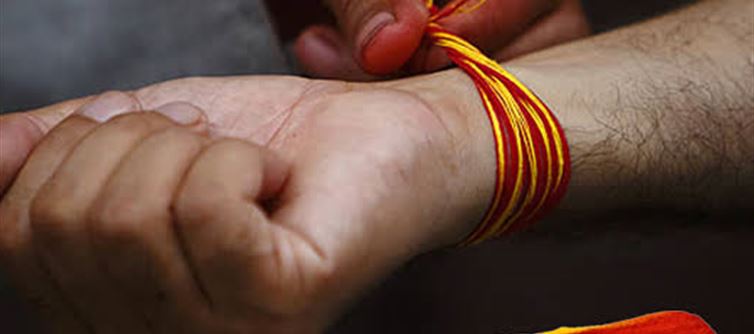
In the vibrant spiritual tapestry of Hindu tradition, the Raksha Sutra—also known as Mauli—holds more than ceremonial value. While it may seem like a simple thread tied around the wrist, it is imbued with deep metaphysical symbolism, ancient legend, and a sacred oath of protection. Far from being a mere ritualistic adornment, the Raksha Sutra is a talismanic force—an embodiment of dharma, divinity, and destiny.
Not Just a Thread, but a Shield
Traditionally tied in hues of red, yellow, or saffron, the Raksha Sutra symbolizes purity, devotion, and spiritual armor. It is worn as a shield against unseen negative energies and malevolent influences that seek to disturb one’s path. When tied with sacred intention and accompanied by Vedic mantras, it becomes more than a piece of thread—it becomes a conduit of divine blessings.
The name itself—Raksha meaning protection and Sutra meaning thread—reveals its purpose: to safeguard. It is often tied during religious ceremonies, havans, and major festivals like Raksha Bandhan—a festival that, though now popularly associated with sibling love, finds its origins in the ancient practice of invoking divine guardianship.
A Mythological Origin Rooted in Dharma
One of the most powerful stories associated with the Raksha Sutra traces back to the legendary confrontation between Bhagawan Vishnu, in his Vamana avatar, and King Bali, the mighty but devout Daitya ruler. According to sacred texts, during the grand yagna conducted by Bali, Guru Shukracharya recognized the disguised Vamana as none other than Lord vishnu himself and warned the king to stop the process. But it was too late.
The Raksha Sutra had already been tied to Bali’s wrist—an act symbolizing a vow of righteousness and commitment. Bound by honor and religion, king Bali could not retract his promise. He offered Vamana whatever he desired. The divine dwarf then measured the entire universe in just two steps. With no space left for the third, Bali offered his own head. vishnu gently placed his foot on it, pushing him to Patala Loka (the netherworld), thereby re-establishing divine order.
This mythological moment has immortalized the Raksha Sutra as a symbol of devatas (gods) triumphing over daityas (demons), and of dharma prevailing over ego.
The Sacred Mantra
When the Raksha Sutra is tied today, a mantra is often chanted, inspired by this very tale:
"Yena baddho balir rājo, dānavendro mahābalah
tena tvām abhibadhnāmi, rakṣe mā chala mā chala"
Translation:
"I tie you with the same Raksha Sutra that was tied to the mighty king Bali, the king of demons. O Raksha, remain steadfast, remain firm."
This mantra is a call to both the divine and the individual—a reaffirmation of one’s commitment to dharma, integrity, and spiritual strength. It is the priest’s way of sanctifying the act and empowering the wearer with the will to walk the righteous path.
More Than Symbolism—A Cultural Bond
Beyond the spiritual and mythological connotations, the Raksha Sutra fosters a profound cultural bond. Whether it is the priest tying it on a devotee, a sister tying it on her brother, or a guru tying it on a disciple, it reinforces a connection of faith, protection, and unity. It reminds the wearer of their duties, encourages humility, and invokes divine presence in daily life.
In today’s fast-paced world, the essence of the Raksha Sutra remains timeless. It is not a degraded tradition, but a misunderstood one—one that carries whispers of cosmic events and divine vows. When tied with faith and understanding, it is not just a ritual—it becomes a silent, sacred warrior on our wrist.




 click and follow Indiaherald WhatsApp channel
click and follow Indiaherald WhatsApp channel